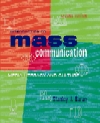The technology for radio was developed in the late 19th century, at about the
same time that sound recording was being perfected. The medium was used in the
early decades of the 20th century for point-to-point communication, and in 1920
KDKA made the first commercial radio broadcast. Advertising became the economic base of radio in the 1920s. Because it offered
free entertainment, radio became increasingly popular during the Great Depression.
This time was known as the golden age of radio, until television began to overtake
it in popularity after World War II. Radio is successful today largely because it is local and specialized, which
appeals to advertisers as well as listeners. The recording industry, on the
other hand, is primarily controlled by four major companies. The two industries
have changed and prospered due to technological advances such as digital recording
and convergence of radio and the Internet. Controversial music file-sharing
software such as Napster may transform the recording industry, in spite of legal
attempts to shut it down. | 


 2002 McGraw-Hill Higher Education
2002 McGraw-Hill Higher Education